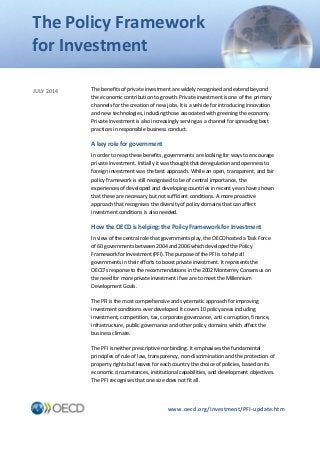
The Policy Framework for Investment - A policy instrument for mobilising investment
- 1. The benefits of private investment are widely recognised and extend beyond the economic contribution to growth. Private investment is one of the primary channels for the creation of new jobs. It is a vehicle for introducing innovation and new technologies, including those associated with greening the economy. Private investment is also increasingly serving as a channel for spreading best practices in responsible business conduct. A key role for government In order to reap these benefits, governments are looking for ways to encourage private investment. Initially it was thought that deregulation and openness to foreign investment was the best approach. While an open, transparent, and fair policy framework is still recognised to be of central importance, the experiences of developed and developing countries in recent years have shown that these are necessary but not sufficient conditions. A more proactive approach that recognises the diversity of policy domains that can affect investment conditions is also needed. How the OECD is helping: the Policy Framework for Investment In view of the central role that governments play, the OECD hosted a Task Force of 60 governments between 2004 and 2006 which developed the Policy Framework for Investment (PFI). The purpose of the PFI is to help all governments in their efforts to boost private investment. It represents the OECD’s response to the recommendations in the 2002 Monterrey Consensus on the need for more private investment if we are to meet the Millennium Development Goals. The PFI is the most comprehensive and systematic approach for improving investment conditions ever developed. It covers 10 policy areas including investment, competition, tax, corporate governance, anti-corruption, finance, infrastructure, public governance and other policy domains which affect the business climate. The PFI is neither prescriptive nor binding. It emphasises the fundamental principles of rule of law, transparency, non-discrimination and the protection of property rights but leaves for each country the choice of policies, based on its economic circumstances, institutional capabilities, and development objectives. The PFI recognises that one size does not fit all. The Policy Framework for Investment www.oecd.org/investment/PFI-update.htm JULY 2014
- 2. Who uses the PFI and in what ways? The PFI has been used by over 25 countries at varying levels of development and across all continents as they have undertaken OECD Investment Policy Reviews (IPRs). African and Southeast Asian countries are using the PFI to conduct IPRs within the frameworks of the NEPAD-OECD Africa Investment Initiative and the ASEAN-OECD Investment Programme. The Investment Reform Index of the Investment Compact for Southeast Europe applies the PFI to measure and communicate progress on investment climate policy reforms. In the Middle East and North Africa, countries are using the PFI to develop and implement business climate development strategies that measure the process of investment policy reform. In Latin America and the Caribbean, a programme based on the PFI was launched in 2010 to increase the contribution of private investment to economic and social development in the region. Established regional economic communities, such as the Association of Southeast Asian Nations (ASEAN) and the Southern African Development Community (SADC), are using the PFI to promote policy harmonisation among their members. Sectoral adaptations of the PFI covering investment in agriculture and investment in clean energy infrastructure are also being used by governments pursuing reforms in specific areas. The impact of a PFI-based country review The PFI fosters cross-government and participatory approaches. IPRs are driven by multi-agency task forces constituted by beneficiary governments themselves. IPRs are characterised by the active participation of a wide range of stakeholders with high-level support. A significant impact of the PFI is its ability to provide a coherent approach to development with country- level policy recommendations, thus building a constituency for reform. This has been seen in Mauritius where the review’s recommendations fed into the country’s 2013 budget; in Zambia where a public private partnership (PPP) training programme was implemented as a result of a recommendation to strengthen the capacities of PPP officials; and, in Myanmar where reforms to promote responsible business conduct are underway and where the International Finance Corporation is using the review as a reference for its in-country technical assistance. Updating the PFI Since the PFI was endorsed in 2006, the global policy landscape has undergone major changes, and the OECD, within the framework of its Development Strategy, has called for a review of the PFI. The experiences of developing countries and regions with investment policy reviews will be used as an integral part of the update. Launched in March 2014 at the OECD Southeast Asia Regional Forum, the update is an inclusive process led by a Task Force co-chaired by Myanmar and Finland. The update is guided by the OECD Advisory Group on Investment and Development and is scheduled for completion in May 2015. CONTACT www.oecd.org/investment/pfi-update.htm Mike Pfister mike.pfister@oecd.org Investment Division Tel. +33 1 4524 8448 Directorate for Finance and Enterprise Affairs Organisation for Economic Co-operation and Development 2 rue André-Pascal – 75016 Paris – France
